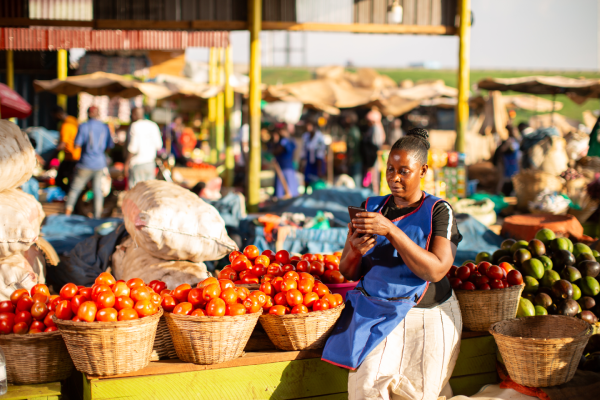Women are 14% less likely than men to use mobile internet in low-and-middle-Income Countries, with 885 million remaining unconnected
14 May 2025, London: Progress in closing the gender gap in mobile internet adoption across LMICs stalled in 2024, according to the ‘Mobile Gender Gap Report 2025’ published by the GSMA today. The report shows that women are 14% less likely than men to use mobile internet, and the underlying rate in women’s mobile internet adoption has slowed. This leaves approximately 235 million fewer women than men using mobile internet in these countries. In fact, there are 885 million women still not using mobile internet across LMICs, approximately 60% of whom reside in South Asia and Sub-Saharan Africa.
The eighth edition of the GSMA report examines data on women’s mobile access and use across 15 LMICs, the barriers they face to adopting and using mobile internet and how this compares with men. Mobile is the primary way that most people in LMICs access the internet, particularly women. Most women report that mobile internet positively impacts their lives. It enhances connectivity, supports livelihoods, and provides access to critical services like healthcare, education, and financial services.
Persistent gender gaps
The report reveals that more women than ever before (63%) are using mobile internet in LMICs, but persistent and substantial gender gaps in adoption and use remain. Between 2017 and 2020, the mobile internet gender gap narrowed substantially, dropping from 25% to 15%. However, progress stalled in 2021 and 2022, when the mobile internet gender gap widened slightly. Promisingly, in 2023, the gender gap narrowed again for the first time in three years, bringing the gap back to 15%; the same level as in 2020, only to remain relatively unchanged at 14% today. The gap remains widest in South Asia and Sub-Saharan Africa, at 32% and 29%, respectively.
Claire Sibthorpe, Head of Digital Inclusion at the GSMA comments: “It’s disheartening that progress in reducing the mobile internet gender gap has stalled. The data highlights the urgent need for increased focus and investment by all stakeholders working together to close the digital gender divide. The mobile internet gender gap is not going to close on its own. It is driven by deep-rooted social, economic, and cultural factors that disproportionately impact women. Our Connected Women Commitment Initiative shows that by taking concrete actions to address women’s needs and the barriers they face, it is possible to drive change. Since this initiative was launched in 2016, our operator partners have collectively reached over 80 million additional women with mobile internet or mobile money services.”
Affordability and literacy and digital skills remain key barriers
While 61% of women in LMICs own a smartphone, that still leaves around 945 million women without a smartphone, 230 million fewer women than men, marking no significant change since 2023. The affordability of internet-enabled handsets remains one of the top barriers to mobile internet adoption, with the cost of an entry-level handset representing 24% of a woman’s monthly income in LMICs, compared with 12% of men’s. Literacy and digital skills is the other top reported barrier to mobile internet adoption among those who are aware of mobile internet.
Even once women are online, they tend to use it less frequently than men and for a narrower range of services, citing barriers including safety and security concerns, affordability (particularly of data, but also handsets) and connectivity experience.
The GSMA estimates that over the period 2023 to 2030, closing the gender gap in mobile internet adoption in LMICs would add $1.3 trillion in additional GDP. Closing the gender gap in mobile ownership and use over this period would also deliver $230 billion in additional revenue to the mobile industry.
The Mobile Gender Gap Report 2025 is funded by the UK Foreign, Commonwealth and Development Office (FCDO) and the Swedish International Development Cooperation Agency (Sida) via the GSMA Mobile for Development Foundation, with research funded in part by the Gates Foundation.
-ENDS-
About GSMA
The GSMA is a global organisation unifying the mobile ecosystem to discover, develop and deliver innovation foundational to positive business environments and societal change. Our vision is to unlock the full power of connectivity so that people, industry, and society thrive. Representing mobile operators and organisations across the mobile ecosystem and adjacent industries, the GSMA delivers for its members across three broad pillars: Connectivity for Good, Industry Services and Solutions, and Outreach. This activity includes advancing policy, tackling today’s biggest societal challenges, underpinning the technology and interoperability that make mobile work, and providing the world’s largest platform to convene the mobile ecosystem at the MWC and M360 series of events.
We invite you to find out more at gsma.com
About GSMA Connected Women
The GSMA’s Connected Women programme works with mobile operators and their partners to address the barriers to women accessing and using mobile internet and mobile money services. Connected Women aims to reduce the gender gap in mobile internet and mobile money services and unlock significant commercial opportunities for the mobile industry and socio-economic benefits for women.
For more information, please visit www.gsma.com/connectedwomen
Media Contacts
GSMA Press Office
[email protected]



